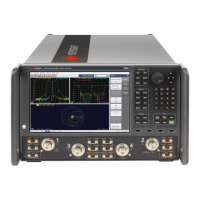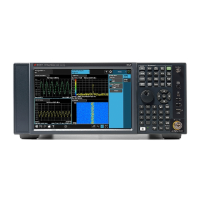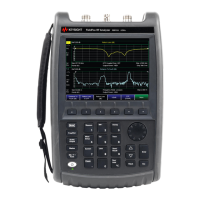Keysight N5221A/22A Service Guide 5-17
Theory of Operation
Signal Separation Group Operation
— the A31 test port 4 coupler and the A24 mixer brick receiver D
— the A32 test port 2 coupler and the A23 mixer brick receiver B
Normal Measurement Configuration
For those analyzers equipped with configurable test set and source
attenuators, with the inclusion of an external amplifier and accessories, you
can calibrate the analyzer and test devices at power levels up to +30 dBm. You
can make measurements in the forward, reverse, or both directions and still
achieve these high power levels.
High Dynamic Range Measurement Configuration
With a few jumper changes, you can configure the measurement configuration
for higher dynamic range measurements. By swapping the front panel jumpers
for one port, signal flow through the corresponding coupler is reversed,
increasing the test signal sensitivity by 15 dB.
In the forward direction, for example, the signal flow through the test port 2
coupler (A32) is reversed by arranging the front panel jumpers such that RCVR
B IN connects to CPLR THRU and CPLR ARM connects to SOURCE OUT.
While increasing forward (S21) dynamic range, the reverse (S12) dynamic
range is degraded by the same amount.
A25–A28 Receiver Couplers
The source incident signals from the A5 and A8 26.5 GHz sources are sent to
the A25–A28 receiver couplers where a portion of each signal is coupled off to
provide the R1, R2, R3, and R4 receiver reference signals for 4-port models or
R1 and R2 reference signals for 2-port models.
These reference signals are routed through front-panel jumpers to the A23 and
A24 mixer bricks. Refer to “A23 and A24 Mixer Bricks” on page 5-21 for
additional information.
The test signals each go through the through-line arm of a receiver coupler,
then through a front panel jumper to the A29–A32 test port couplers.
A29–A32 Test Port Couplers
The test port signals go into the through-line arm of the couplers, and from
there to the test ports and the DUT.
The coupled arm of the couplers carries the signal reflected from or
transmitted through the DUT, to the receiver for measurement (through front
panel jumpers), as inputs A, B, C, and D for 4-port models or inputs A and B for
2-port models. The coupling coefficient of the directional couplers is nominally
15 dB over the full frequency range.

